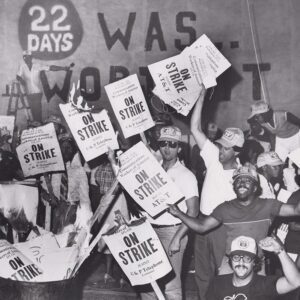April 30, 2017
Fighting for Workplace Safety
(This article first appeared in the May-June 2017 issue of The American Postal Worker magazine.)
Before passage of the Occupational Safety and Health Act in December 1970, millions of Americans risked their lives every time they reported for duty – there were no national safety laws designed to protect workers across industries.
In 1970, groundbreaking legislation created the Occupational Health and Safety Administration (OSHA), which is responsible for setting workplace safety and health regulations.
Risking Lives on the Job
In the 1800s, factory workers were often mauled in grisly workplace accidents. In 1877, Massachusetts passed the nation’s first factory-inspection bill, and other states passed similar measures. State laws, however, were largely ineffective as many industries were not covered, and enforcement was weak. Newspapers reported tens of thousands of workplace deaths each year.
Although Congress created the Department of Labor (DOL) in 1913, most workplace regulation was left up to individual states, which declined to sufficiently fund inspection procedures and enforcement measures.
In the 1930s, President Franklin D. Roosevelt appointed Frances Perkins, an advocate for workplace safety, as Secretary of Labor. With union support, Perkins helped create the Bureau of Labor Standards in 1934 to ensure workplaces were “as safe as science and law can make them.”
For the next three decades, union efforts to expand workplace safety laws were slowed by opposition from employers, who found it cheaper and more profitable to replace dead or injured workers than to create safe workplaces.
Taking Action
Labor unions began clamoring for the federal government to act. The Oil, Chemical and Atomic Workers (OCAW), which represented workers in some of the most dangerous industries in the country, pushed for health and safety language in contracts. OCAW organized public hearings around the country with doctors, scientists and community activists to expose dangerous workplace hazards and to push for federal legislation.
Feeling their pressure, the U.S. Public Health Service issued the 1965 report, “Protecting the Health of Eighty Million Americans.” It found that a new chemical entered the workplace every 20 minutes, and evidence showed a strong link between cancer and the workplace. It also reported that old problems were far from being eliminated, and called for a major national campaign to improve occupational health.
After years of debate between political parties about workplace safety – as well as more and more worker injuries and deaths – Congress passed the Occupational Safety and Health Act in November 1970, creating OSHA. A month later, it was signed into law.
A Lasting Impact
OSHA was created to improve and enforce safety standards to reduce workplace hazards; to research occupational safety and health; to maintain a record-keeping system to track violations and work-related casualties, and to establish occupational safety training programs.
On the positive side, in the 40 years since the enactment of the OSH Act, workplace safety has improved dramatically. Fatalities and debilitating injuries have decreased; occupational diseases such as “brown lung” have all but disappeared, and OSHA standards are in place to limit workplace exposure to asbestos, lead, cotton dust, and other hazardous material. Yet, there are still far too many injuries and deaths caused by corporate greed, and OSHA has been undermined and weakened.
Workers Memorial Day is April 28
The labor movement observes Workers Memorial Day on April 28, to commemorate those who have been killed or injured on the job and to revitalize the fight for workplace safety.
Each year, thousands of workers die and millions more are injured or sickened from dangerous working conditions. Many employers routinely cut corners and violate the law. Fewer workers are reporting hazards and injuries because
they are afraid of being harassed or fired.
According to OSHA, between Oct. 1, 2015 and Sept. 30, 2016, nearly 5,000 workers were killed on the job and nearly 2.9 million suffered from non-fatal injuries or illnesses.
APWU members are encouraged to participate in Workers Memorial Day events. To find one near you, visit aflcio.org/Issues/Job-Safety/WorkersMemorialDay.
In 2015, the APWU launched the Stand Up for Safe Jobs campaign, encouraging workers to be aware of the many dangers on the job, and to actively fight together for safe working conditions. Go apwu.org/issues/safe-jobs to learn more.



